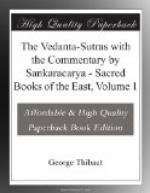the word avyakta which occurs in the text can denote
only the subtle body, but not the gross body which
is vyakta,
i.e. developed or manifest; we invalidate
this rejoinder by remarking that the determination
of the sense depends on the circumstance of the passages
interpreted constituting a syntactical whole.
For if the earlier and the later passage do not form
a whole they convey no sense, since that involves
the abandonment of the subject started and the taking
up of a new subject. But syntactical unity cannot
be established unless it be on the ground of there
being a want of a complementary part of speech or
sentence. If you therefore construe the connexion
of the passages without having regard to the fact that
the latter passage demands as its complement that
both bodies (which had been spoken of in the former
passage) should be understood as referred to, you
destroy all syntactical unity and so incapacitate yourselves
from arriving at the true meaning of the text.
Nor must you think that the second passage occupies
itself with the subtle body only, for that reason
that the latter is not easily distinguished from the
Self, while the gross body is easily so distinguished
on account of its readily perceived loathsomeness.
For the passage does not by any means refer to such
a distinction—as we conclude from the circumstance
of there being no verb enjoining it—but
has for its only subject the highest place of Vish/n/u,
which had been mentioned immediately before. For
after having enumerated a series of things in which
the subsequent one is always superior to the one preceding
it, it concludes by saying that nothing is beyond
the Person.—We might, however, accept the
interpretation just discussed without damaging our
general argumentation; for whichever explanation we
receive, so much remains clear that the Ka/th/aka passage
does not refer to the pradhana.
4. And (the pradhana cannot be meant) because
there is no statement as to (the avyakta) being something
to be cognised.
The Sa@nkhyas, moreover, represent the pradhana as
something to be cognised in so far as they say that
from the knowledge of the difference of the constitutive
elements of the pradhana and of the soul there results
the desired isolation of the soul. For without
a knowledge of the nature of those constitutive elements
it is impossible to cognise the difference of the
soul from them. And somewhere they teach that
the pradhana is to be cognised by him who wishes to
attain special powers.—Now in the passage
under discussion the avyakta is not mentioned as an
object of knowledge; we there meet with the mere word
avyakta, and there is no sentence intimating that the
avyakta is to be known or meditated upon. And
it is impossible to maintain that a knowledge of things
which (knowledge) is not taught in the text is of
any advantage to man.—For this reason also
we maintain that the word avyakta cannot denote the
pradhana.—Our interpretation, on the other
hand, is unobjectionable, since according to it the
passage mentions the body (not as an object of knowledge,
but merely) for the purpose of throwing light on the
highest place of Vish/n/u, in continuation of the
simile in which the body had been compared to a chariot.




